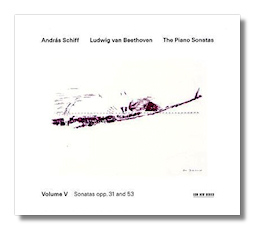
The Internet's Premier Classical Music Source
Related Links
- Beethoven Reviews
- Latest Reviews
- More Reviews
-
By Composer
-
Collections
DVD & Blu-ray
Books
Concert Reviews
Articles/Interviews
Software
Audio
Search Amazon
Recommended Links
Site News
 CD Review
CD Review
Ludwig van Beethoven

Sonatas for Piano, Volume 5
- Sonata #16 in G Major, Op. 31 #1
- Sonata #17 in D minor "The Tempest", Op. 31 #2
- Sonata #18 in E Flat Major "The Hunt", Op. 31 #3
- Sonata #19 in C Major "Waldstein", Op, 53
- Andante favori in F, WoO 57
András Schiff, piano
ECM New Series 1945/46 DDD 2CDs 71:56, 34:05
Schiff passes the halfway point in his chronological series of Beethoven sonatas with this release. As before, the sonatas have been recorded live in Zürich's Tonhalle. We can sense and sometimes hear the appreciation of the audience; there's a little nervous expectation in the air that comes across even on the CDs, in addition to the occasional rustle or throat-clearing. None of this is obtrusive. The sound of the piano is not brilliant, but it is realistic.
Schiff seems more comfortable with these middle-period sonatas than he did with those from the beginning of the cycle… or at any rate, what he has to say about them is more distinctive. While not precisely understated, there is much subtlety to these readings, and Schiff seems to be getting in touch with Beethoven's core, not just his public persona. These are not heaven-storming performances. They are insinuating and sometimes even sly. For example, he turns the Scherzo of Op. 31 #3 into a witty moto perpetuo, as if it were a machine waiting to be set into motion. The finale of the "Tempest" Sonata also has an insistent quality, but here the effect is more haunting. Schiff brings strange creatures to life in this movement.
Nor does he play it too quickly – a common fault. In general, Schiff's tempos are slower than those of most pianists, and when he cuts loose – as in the finale of the "Hunt" Sonata – it isn't for the sake of virtuosic display. Furthermore, he's metronomic only when it is in the music's character to be so. Most of time he lets his tempi follow the music's ebb and flow. One can tell that Schiff approaches these works not just as pianistic or technical hurdles, but also as intellectual puzzles waiting to be solved. Sentiment is given its due, but there is no sentimentality.
This is borne out by the long booklet note, which is an interview between the pianist and Martin Meyer. Anyone interested in playing these works – or in hearing them with fresh ears – should read Schiff's well-considered thoughts about them. The inclusion of the Andante favori as both an appendix and an encore is typically thoughtful. (This, of course, was Beethoven's first attempt at a middle movement for the "Waldstein.")
Schiff's Beethoven series is going from strength to strength.
Copyright © 2007, Raymond Tuttle




















